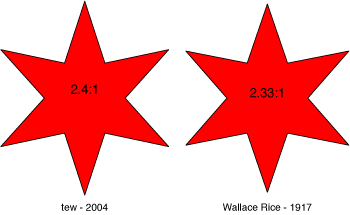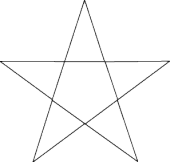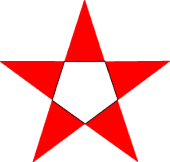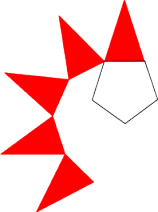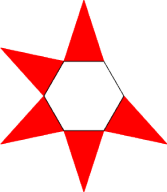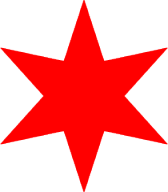The flag of the city of Chicago is rich in history and symbolism. In fact, the municipal code specifies, in some detail, the design and meaning of each of the flag’s elements. However, the code also leaves much to interpretation, especially the shape and placement of the stars.
There shall be four bright red stars with sharp points, six in number, set side by side, close together, next to the staff in the middle third of the surface of the flag.
So we’ve got four stars with six sharp points, close together. Here are a few interpretations of this instruction from around the web.




The first is from a patch the Chicago Fire sell. Next we have the stars from the Chicago Public Library information on the flag page. Then the stars from Wikipedia’s Chicago Flag entry. Finally, the stars from an eBay auction of an “authentic” Chicago Police flag patch.
All of the above representations are very nearly perfect hexagrams . The star polygon {6/2} is made from six points, equally spaced upon a circle, connected via straight lines. It’s also known as the “Star of David”, and you may recognize it as the preeminent symbol of Judaism. Would the points of the hexagram be characterized as “sharp?” Not compared to the pentagram, which you may recognize as the “normal” five-pointed star.
The pentagram has a “pointy” angle of 36 degrees (more about this angle later), but the hexagram is somewhat dull, with only a 60 degree point. Fortunately, most actual Chicago flags feature a, um, pointier star.


The first is from an actual photograph of an actual flag , flying in front of a downtown church. The other is from eBay auctions of real flags.
These stars are considerably sharper or “pointier” than the regular Star of David. To my eye, they look much more “Chicago” than the more regular 6-pointed stars. How much pointier should the stars be? Well, I’ve come up with a system by which we can derive the proper shape of the Chicago flag’s star, and I’ll suggest it as the future standard by which all Chicago flag stars should be constructed.
First, consider the pentagram. We can all agree that its points are “sharp” and its proportions are pleasing. Interestingly, its points are golden triangles, well known to be pleasing to the eye. Let us construct a six-pointed star according to the same pleasing principles.
First, construct a regular hexagram:

Using the hexagon produced inside, plan a golden triangle as the point.
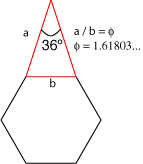
Multiply this triangle for each face of the hexagon and fill with red.
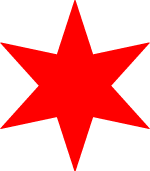
Here we have what I think are the proper proportions for the Chicago star. It is certainly distinct from the Star of David, but is also founded upon geometrical principles and resembles in proportion (golden proportion!) the five-pointed stars we know so well.
I’ve also helpfully calculated the ratio between the inner and outer radii. The outer radius (the circumradius) is 2.4 times the length of the inner radius (which, in Adobe parlance, is the circle which intersects the points of concavity, not the incircle of the hexagon). I won’t show my work here, but let me tell you, it was a pretty good review of sophomore year trig to get this number. Now that I’ve done all the work, you can use Adobe Illustrator to create these stars effortlessly. Here’s the relevant dialog box:
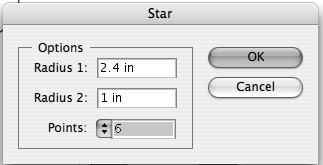
Please feel free to call or write to your alderman about this issue. Let’s get this taken care of, Chicago!
